High Technology
-
- The Posture Of The Navy Marine Corps Team — Fiscal Year 1984 — Maritime Reporter, Jun 1983 #21
Two years ago the President presented to Congress a program to reverse more than a decade of declining American military strength. In the preceding 10 years, real defense spending had declined 22 percent; our nuclear megatonage had been cut in half; our strategic bomber force had declined by 25 percent, our ballistic missile submarine force had dropped from 41 to 31; and our Navy had been slashed from nearly a thousand ships to 468, and from 23 aircraft carriers to 12.
During this same decade, the Soviet Union carried out one of the greatest peacetime military expansions in history. Since 1965, the Soviets increased military spending by about four percent real growth annually, nearly doubling their spending over that period. This growth, has been most noticeable in the Soviet Navy. Only a coastal defense force two decades ago, it is now a modern "bluewater" fleet capable of global power projection.
These adverse trends led the CNO to testify before Congress that the United States Navy no longer enjoyed superiority at sea.
In responding to this situation, President Reagan set a clear objective for the Navy and Marine Corps to regain clear maritime superiority within this decade.
As the President put it: "Though the Soviet Union is historically a land-power, virtually self-sufficient in mineral and energy resources and land linked to Europe and the vast stretches of Asia, it has created a powerful blue ocean Navy that cannot be justified by any legitimate defense need. It is a Navy built for offensive action, to cut free world supply lines and render impossible the support by sea of free world allies. By contrast, the United States is a naval power by necessity, critically dependent on the transoceanic import of vital strategic materials. Over 90'/'< of our commerce between continents moves in ships. Freedom to use the seas is our nation's lifeblood. For that reason, our Navy is designed to keep the sea lanes open world-wide.
Maritime superiority for us is a necessity. We must be able in time of emergency to venture in harm's way . . . to assure our access to all oceans of the world.
Failure to do so will leave the credibility of our conventional defense forces in doubt. We are . . . building a 600 ship fleet including 15 earl ier battle groups." Maritime superiority is but one element of our national strategy.
Nonetheless, it is a fundamental requirement, necessary for the success of any national strategy.
The program put before Congress two years ago to achieve this objective was built upon seven elements.
— First, a more realistic strategy for the use of Navy- Marine Corps forces to maximize their deterrence in peacetime, and to prevail if deterrence failed.
— Second, the restoration of the quality, training and morale of our personnel.
— Third, the enhancement of Navy and Marine Corps readiness through adequate maintenance, repair, spare parts and support.
— Fourth, the importance of our sea based nuclear deterrent, the most survivable and enduring component of the U.S. strategic triad.
— Fifth, the establishment of a shipbuilding, reactivation and conversion program to increase the force with the right kinds of ships and to save an industrial base on the verge of collapse.
— Sixth, to establish an aircraft modernization and procurement program to restore aircraft numbers and quality to meet operational requirements.
— Seventh, to build up stocks of ammunition and missiles to realistic objectives for sustaining combat.
The Navy and Marine Corps recovery program in pursuit of these objectives has been underway for two years. The budget for FY-84 will be the fourth Reagan defense recovery budget, counting the 1981 Supplemental and the 1982 revision. I am happy to report that the program is on course and we are moving closer to the achievement of many of our key objectives.
The effects are apparent everywhere in the Navy and Marine Corps. The dramatic benefits of these changes — greater strength, confidence, and capability — far outweigh the costs as we strive to meet the challenge of increasing Soviet military power.
The coming of Chairman Andropov to power has failed to produce any discernible change in the expansive thrust of Soviet m i l i t a r y strength. Thus the growth of Soviet naval capability and the emphasis on a global scope for its operations continues unabated.
During 1982, Soviet naval operations showed advances in sophistication and capability. For the first time, exercises were conducted by BACKFIRE bombers against U.S. carrier groups. We saw the first attempts by air-toair missile-armed FORGER V TOL aircraft to intercept U.S.
naval aircraft. Another new element was the participation of the carrier KIEV in support of Shield 82, a large Warsaw Pact exercise. In Southwest Asia, Cam Ranh Bay provided support for another innovation — a Soviet carrier battle group, headed by MINSK, deployed to the Indian Ocean. Closer to home, the dispatch of a task force to Cuba highlighted the increasing importance to the Soviet Navy of its Caribbean enclave.
Soviet and Warsaw Pact shipyards continued their steady stream of deliveries to the Soviet Navy during 1982. During 1983, we are expecting to see the first deployments of the third KIEV class carrier, the first of the nuclear-powered TYPHOON class ballistic missile submarines, and the initial BLACK-COM-1 class cruisers. The fourth KIEV class carrier is fitting out, and the second KIROV class nuclearpowered cruiser is nearing completion.
Large destroyers of the SOVREMENNYY and UDALOY classes continue in production at two major yards. There are seven submarine classes now in production.
Evidence mounts that a large conventional carrier program is underway. BACKFIRE bombers continue to enter the Soviet Naval Air Force. The new HELIX anti-submarine helicopter is beginning to replace the older HORMONE, and in 1982 HELIX was deployed for the first time on a carrier of the KIEV class.
Polish shipyards continued to supply amphibious warfare ships and repair ships to the Soviet Navy, despite the turmoil in that nation.
The USSR continues, in its role as the world's largest exporter of naval hardware, to devote a portion of its naval shipbuilding capacity to foreign exports. Cuba, in 1982, received more arms shipments from the USSR than in any year since 1962. Libya, Algeria, and India all received major deliveries of Soviet naval equipment.
Perhaps, even more important than the litany of new classes of Soviet naval ships and aircraft, is the incremental improvement of weapon and sensor systems that support those ships and aircraft. New missiles, guns, mines, torpedoes, radars and sonars are joining the Red Fleet, aided in part by the continued transfer of Western technology.
Soviet exploitation of Western scientific achievements constitutes a major threat, not only to our military forces, but also to the very fiber of the Western industrial economy.
The share of the Soviet defense budget allocated to the Soviet Navy has been steady for many years. As that budget grows in absolute terms, so does the capability of their fleet. I have highlighted some of the major programs and operations of the last year, but it is astonishing to view the across-the-board accomplishments of Soviet naval industry and the Soviet Fleet. A balanced naval force has been developed, with support requirements receiving attention along with combatant elements. It is this dedication to the broadest concept of seapower that permits the Soviet Navy to operate globally today.
In addition to the primary threat of Soviet naval and landbased forces, the United States Navy and Marine Corps must be able to cope with potential threats from other forces as well. Two recent incidents — in 1981 when U.S. forces were engaged by Libyan forces in the Gulf of Sidra, and the 1982 conflict in the Falklands, where anti-ship cruise missiles and nuclear attack submarines were used in combat for the first time, illustrate graphically that there is no "low threat area" for U.S. Navy and Marine Forces committed to a global mission.
In the face of these diverse threats, we set as a major goal the creation of a realistic strategy for the use of our forces.
Current naval strategy for the achievement of maritime objectives is built upon a number of fundamental premises. First, the Soviet threat to the maritime lifelines of the free world is now permanently deployed in every area of our vital interests. It follows that a conventional naval conflict between east and west cannot be limited to a single ocean region. Second, the global nature of our naval forces derives from the commitments of some forty treaty relationships.
For the Navy and Marine Corps these requirements are not matters of choice. They must all be met.
The implication of these two premises is far-reaching. The disposition of forces on both sides has changed dramatically in the past decade. In contrast to ten years ago, the Soviets now have a Pacific Fleet of some 765 ships and combatant craft, they operate from forward bases such as Cam Ranh Bay and DaNang in Vietnam. At the same time, the lower 48 United States have become dependent for one-third of their oil on the Alaskan sea lanes.
Thus, the United States can no longer consider abandoning one ocean to reinforce another in time of conventional war.
A third major premise is that the West can no longer rely on a passive defensive posture at sea. We do not have the merchant tonnage to sustain heavy losses in a submarine war of attrition as we did in World War II.
The Soviets today have over 280 attack submarines; Hitler began the second World War with fewer than 50 ocean-going submarines.
The Soviet's massive fleet of diesel and nuclear attack submarines, exercises regularly with the intention of wartime operations from areas much closer to the North Atlantic than the Kola Peninsula. Our response to the threat directed at our maritime vulnerability cannot simply be to throw a passive barrier across the Greenland-Iceland-UK gap.
We must be able to prevent the Soviets from gaining the initiative and thus enabling their submarines to prey on shipping in the Atlantic and Pacific.
Similarly, NATO must command the entire Mediterranean Sea if the security of the southern tier members of NATO is to be ensured. Let us not overlook an important consequence that flows from NATO control of the flanks. Successful achievement of NATO objectives on both flanks will compel the Soviets to divert forces, ultimately denying Moscow the advantage of concentrating all of its military power for an assault in central Europe.
Thus our maritime strategy must be based on a forward defense.
Such a successful strategy at sea is not, as some armchair strategists would suggest, an alternative to a coalition defense of Europe. Nor does it impede a strong, and modernized conventional land defense of NATO.
Instead, our maritime strategy complements these objectives. Its achievement is a necessary prerequisite for the success of any NATO defense. Similarly, in the Pacific and Indian Ocean theatres, favorable geography and the naval and land-based forces of the U.S. and its allies provide a clear strategy for success.
Much progress has been made in the past two years towards redesign of our peacetime forward deployments, our exercises, and our integration of Navy, Marine Corps, Air Force and Army assets to implement this strategy. Since World War II, Presidents have made use of forward deployed battle groups and Marine amphibious forces more than 250 times to preserve peace.
Regular forward naval deployments are recognized as stabilizing and a deterrent to conflict.
The Falklands offered a stark contrast. If the United Kingdom had indicated its intention to continue regular peacetime deployments to the Falklands, it might have avoided that tragic conflict.
But peacetime deployments are not merely to show resolve or to manage crises. For the Navy and the Marine Corps, they are also the best method to enhance training and readiness. In keeping with our new strategy, we have completley reordered our peacetime deployments to add more realistic multi-carrier operations, greater flexibility for theatre commanders, and far more useful training, while at the same time reducing the time spent away from homeport by Navy and Marine Corps personnel.
This new method of deployment, called "FLEXOPS", has resulted in multiple carrier exercises in the Norwegian Sea, the Eastern Mediterranean, the Caribbean and the Aleutians. It has significantly enhanced the readiness, morale, and flexibility of our naval forces.
In 1982, the Navy and the Marine Corps participated in more than 157 exercises world-wide, a third of which were joint or combined exercises with other U.S.
services or our allies. These operations were conducted in all types of conditions — arctic, desert, and jungle. The capabilities of our Marine amphibious forces continue to be dramatically demonstrated in Lebanon, where they are serving with great restraint under difficult conditions.
At the mid-point of the Regan naval recovery program it is evident that its success has been made possible by the dramatic reform of development and procurement in the Department of Defense. Two years ago, Secretary Weinberger reversed a long and disastrous trend towards centralization of management and diffusion of accountability. His leadership has brought about a new discipline and a new accountability.
Management authority has been returned to the Service Secretaries and far-reaching reforms have been undertaken. I would emphasize five key changes in the Department of the Navy: — First, stability in the program, avoiding the ragged ups and mostly downs of five year plans changing from year to year.
— Second, discipline and accountability in contracting, which involves a fair sharing of the risk between the government and its contractors, providing an incentive for increased profits for excellent performance, and con tractor assumption of the risk— and cost—of bad performance.
— Third, competition, not merely in source selection but in procurement through second sourcing wherever possible.
— Fourth, the firm disciplining of a habitual search for greater capabilities to meet ever increasing requirements. Unfortunately, the best can be the enemy of the good enough. Goldplating is now under control.
— Fifth, the investment in high technology to save money as well as increase capability.
Let me elaborate on this last point. Staying on the frontier of high technology is expensive. But a high technology approach has paid off handsomely to the Navy and to the taxpayers. High technology has provided our margins of superiority in virtually every important area, including that which is least understood — affordability.
For instance, twenty years ago a cruiser required 1,687 enlisted men and 116 officers.
Today the AEGIS cruiser— many times more capable than the vessel it replaces—is manned by 300 enlisted men and 26 officers.
Another good example is the F/A-18. Because of investment in high technology, this aircraft is currently requiring about one-third of the maintenance hours per flight hour of the aircraft it replaces. As a result, we are able to man F/A-18 squadrons with 50 fewer personnel than the aircraft squadrons they replace. This investment in high tech has paid off handsomely in aircraft safety as well. The current generation of naval aircraft, such as the F/A-18, has a safety record twenty times better than the so-called simple jet fighters of thirty years ago.
Results: As a result of the aggressive application of these management reforms, the original naval recovery program of two years ago is still on course despite a succession of budget cuts below President Reagan's initial plan. Some specific accomplishments have been: — Difficulties with the shipbuilding industry in constructing ships have been resolved.
After years of disputes, delays and overruns in our submarine construction programs, all submarines have been delivered on or ahead of schedule and within budget for the last year. For the first time in decades, there is not a single shipbuilding claim outstanding against the Navy.
— Aircraft Carriers. The contract for CVN-71, the Theodore Roosevelt, was renegotiated, reducing the price by nearly $100 million and shortening the contract delivery date by 14 months.
The contract for CVN-72 and CVN-73 was negotiated at an ex- pected savings to the taxpayer of $750 million.
— AEGIS Cruisers. Bath Iron Works was selected as a second source to compete with Litton for procurement of AEGIS cruisers in subsequent years.
— Battleships. New Jersey was recommissioned in December, 1982 — a two billion dollar weapon system for $326 million, five weeks ahead of schedule and under budget. This is a superb example of the prudent use of existing capital assets for which the previous generation of taxpayers has already paid.
— Build / Convert-and-Charter Programs. To obtain maritime prepositioning ships quickly and efficiently, we have turned to build/convert-and-charter programs.
Studies have shown that in terms of present value, we will save over $35 million per ship by chartering rather than purchasing.
After accounting for tax aspects, the savings to the Treasury will still be over $28 million per ship. The contracts are for cargo-carrying services which were awarded competitively at prices that will save the American taxpayers millions of dollars. The program also provides a positive impetus to the beleaguered U.S. Merchant Marine and to the depressed U.S.
shipbuilding industry. Without such work, many of these shipyards would have closed. They remain in business today providing jobs and an industrial base for the Navy of the future.
Overall in shipbuilding, 25 ships were delivered to the Navy during 1982. Twenty ships were a total of 11 months ahead of schedule. Nineteen ships were on or below budget.
These and other management initiatives have already resulted in such efficiencies that, despite some cuts in previous Navy budgets, we remain on course. The American taxpayer is clearly getting his dollar's worth of national security from the naval recovery program.
Two years ago we set forth a program intended to recapture maritime superiority for the United States. It was based on a 600-ship Navy, built around 15 battle groups. At that time, some said it would not be done— that such a Navy would detract from other commitments, that both technology and innovation in naval warfare made surface ships vulnerable and obsolete.
Others said that it could not be done, that we lacked the ships, the money, the men, and above all, the management capability to oversee such an undertaking.
But events over the past two years have confounded the critics.
The continued growth of Soviet forces and the Falklands conflict have confirmed our choices. The 600-ship Navy is well on its way. Accompanying the expansion of force structure has been an increasing recruitment of high quality personnel. Existing forces have been made more ready. Morale is high. We have demonstrated that we can manage the naval recovery program effectively, with many elements delivered ahead of schedule and under budget. We have tried very hard to be worthy of the confidence placed in us by the Congress and the American people.
Strategic planning, capable management and skilled personnel, are not however, the only requisites for achievement of our goals. As Disraeli so aptly put it, "The secret of success is constancy of purpose." At this mid-point in our naval recovery program, the secret of success is, indeed, the constancy of our purpose. The United States is well on its way toward maritime superiority. I am certain that we shall achieve it.
-
- Two Brochures Available On Sperry's Doppler Speed, Navigation Systems Maritime Reporter, Oct 15, 1981 #16
or retrofitting. The second eight-page brochure provides similar technical information on Sperry's Doppler Navigation Sonar (DNS). The DNS is a high-technology navigation system designed for use as a bottom and or water reference navigator for submersibles and surface vessels. Used in conjunction wit
-
- CRC Welding Systems Moves To Houston Maritime Reporter, Nov 1983 #18
, announced the move of its CRC Welding Systems, Inc. operation from Nashville to Houston. CRC Welding Systems designs and manufactures high technology welding equipment systems and controls for a variety of industrial applications, including robotic welding. Featured products include THRUARC
-
- Brochure Available On Six Operating Divisions Of Grinnell Valve Maritime Reporter, Aug 1980 #51
of ITT Grinnell Corporation, the Valve Company manufactures and distributes a full line of valves from rugged fire hydrants to sophisticated, high technology control valves in sizes from ^-inch to 12 feet in diameter, utilizing a range of materials from titanium alloys to basic castings of gray
-
- C y b e r n e t I n t r o d u c e s N ew V H F - F M R a d i o t e l e p h o ne — L i t e r a t u r e A v a i l a b le Maritime Reporter, Apr 15, 1984 #10
The Cybernet CTX-2050 is a fully synthesized 50-channel VHFFM radiotelephone designed to the very highest standards of modern high-technology electronics. This new unit covers all U.S. VHF-FM marine channels including five U.S.; and Canadian weather channels. It features a Channel 16 quick-select
-
- N a v y A w a r d s E-Systems $ 4 . 7 - M i l l i o n C o n t r a ct Maritime Reporter, Apr 15, 1984 #18
from missiles in flight. It can function with both the Terrier and Tartar missiles. E-Systems is a major worldwide developer and producer of high technology electronic systems and products in the areas of intelligence and reconnaissance systems, command and control, electronic warfare, specialized
-
- Bailey Meter Is Now Bailey Controls Company Maritime Reporter, Jul 15, 1978 #18
& Wilcox, has received a new name—Bailey Controls Company. "Our new name more accurately reflects the true nature of our business today, which is high technology control and instrumentation systems and products for the electric utility, industrial processes and marine industries," said Bailey president
-
- Resistoflex Offers Free Literature On High Performance Fluid Systems Maritime Reporter, Nov 1986 #71
high-performance fluid connectors for militiary marine use. From initial design to actual installation installation, Resistoflex integrates high technology with operational requirements to meet high-temperature, high-pressure, no-leak demands of fluid systems. Resistoflex's Dynatube® Teflon hose
-
- Free 24-Page Technical Article On Asbestos-Free Packing Materials Offered Maritime Reporter, Nov 1986 #80
for Elevated Temperature Service." The article describes a test program conducted to evaluate asbestos- free valve stem packing materials proposed for high-temperature service. Packing gland bolt loads, stem frictional loads, and packing compression were measured with room temperature water at pressures to
-
- Magnavox Names Manager Of Marketing Services Maritime Reporter, Sep 1986 #28
navigation products and systems worldwide Ms. Dale is an experienced marketing communications specialist with a wide background in marketing high-technology products. She was formerly account manager for GenRad, Inc., with responsibility for two automatic test equipment product lines, and
-
- Marinette Marine Delivers Last Of 52 Workboats A Year Ahead Of Schedule Maritime Reporter, Feb 1986 #6
, is a company of marine design engineers and shipbuilders specializing in the design and construction of defense related marine vessels, and high technology commercial craft. For further information on Marinette Marine, Circle 7 ori Reader Service Car
-
- Rockwell Offers Free Technical Article On Fire-Seal® Butterfly V a l v es Maritime Reporter, Apr 1986 #100
performance before, during and after exposure to severe fires. The Flow Control Division of Rockwell International is a leading supplier of high-technology industrial valve and actuator products for worldwide electric power, oil and gas, chemical process and general industrial markets. For
-
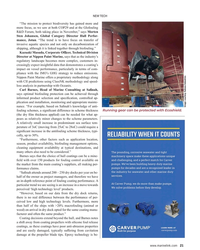 )
February 2025 - Maritime Reporter and Engineering News page: 21
)
February 2025 - Maritime Reporter and Engineering News page: 21we have an in-depth reference point of fouling coating performance. A particular trend we are seeing is an increase in a move towards perceived ‘high technology level’ products. “However, based on our data from the dry dock returns, there is no real difference between the performance of per- ceived low
-
![MT Sep-24#30 Limited [Tritech]
is a high-technology business dedicated](https://images.marinelink.com/images/magazines/w200h250c/MarineTechnology-202409-page32.png) )
September 2024 - Marine Technology Reporter page: 30
)
September 2024 - Marine Technology Reporter page: 30MTR 100 TRITECH INTERNATIONAL LTD www.tritech.co.uk Tritech International Limited [Tritech] is a high-technology business dedicated to providing imaging and ancillary equip- ment for use in underwater applications. Its product portfolio consists of a suite of Mechanically Scanning and Multibeam
-
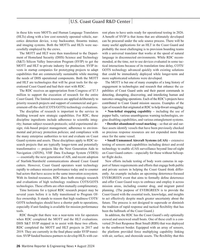 )
August 2024 - Maritime Reporter and Engineering News page: 26
)
August 2024 - Maritime Reporter and Engineering News page: 26With its limited resources, RDC does both strategic research EVERGREEN event that aims to formally de? ne deterrence and evaluations of high technology readiness COTS/GOTS and offer Coast Guard ways to embrace and employ it across technologies. These efforts are often mutually complimentary
-
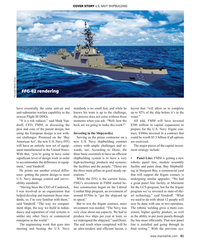 )
February 2022 - Maritime Reporter and Engineering News page: 41
)
February 2022 - Maritime Reporter and Engineering News page: 41? cant level of design work in order shipbuilding system is to have a very • Panel Line: FMM is getting a new to accommodate the difference in equip- high-technology products and systems; robotic panel line, module assembly ment,” said Vandroff. the facilities and the people. “Those are facility and
-
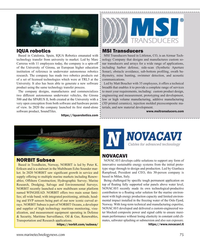 )
September 2021 - Marine Technology Reporter page: 75
)
September 2021 - Marine Technology Reporter page: 75Oslo Fjord, rays. NORBIT Subsea is part of NORBIT Oceans, a developer Norway. With long-term technical and manufacturing expertise, and supplier of high technology maritime monitoring, visu- NOVACAVI developed and delivered a custom-engineered wa- alization, and measurement equipment operating in Defense
-
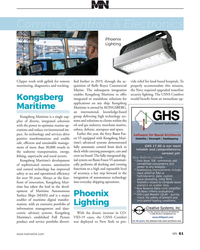 )
August 2020 - Marine News page: 61
)
August 2020 - Marine News page: 61up- Kongsberg applications on any ship. Kongsberg Maritime is owned by KONGSBERG, Maritime an international, knowledge-based group delivering high technology sys- Kongsberg Maritime is a single sup- plier of diverse, integrated solutions tems and solutions to clients within the oil and gas industry
-
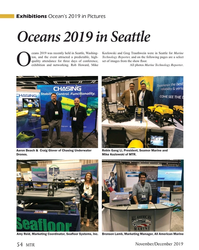 )
November 2019 - Marine Technology Reporter page: 54
)
November 2019 - Marine Technology Reporter page: 542019 was recently held in Seattle, Washing- Kozlowski and Greg Trauthwein were in Seattle for Marine ton, and the event attracted a predictable, high- Technology Reporter, and on the following pages are a select quality attendance for three days of conference, set of images from the show ? oor
-
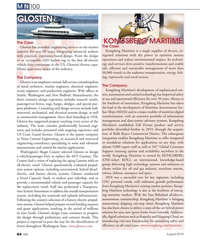 )
August 2019 - Marine News page: 64
)
August 2019 - Marine News page: 64owned by KONGSBERG County had a vision of replacing the aging Guemes with an (OSE-ticker: KOG), an international, knowledge-based group delivering high technology systems and solutions to all-electric vessel. Glosten quantitatively evaluated propul- clients within the oil and gas industry, merchant marine
-
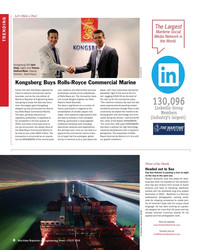 )
July 2018 - Maritime Reporter and Engineering News page: 8
)
July 2018 - Maritime Reporter and Engineering News page: 8emerging “For more than 200 years KONGSBERG not yet announced, the stated value of data-driven products and applications. has been a pioneer for high technology the Rolls-Royce Commercial Marine to But perhaps even more so, the deal is a industrial development with a long term be sold at just under
-
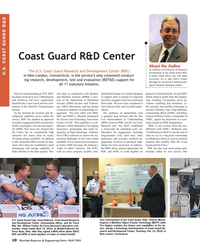 )
May 2018 - Maritime Reporter and Engineering News page: 10
)
May 2018 - Maritime Reporter and Engineering News page: 10that innovation, prototyping and rapid in- a framework for immediate joint col- af? liation with AFRL,” Rothrock said. the Center has an exceptionally high tegration of high-technology readiness laboration for engagement; including “Establishing an MOU is just the start of transition rate drawn from
-
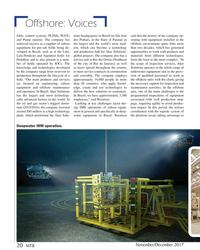 )
November 2017 - Marine Technology Reporter page: 20
)
November 2017 - Marine Technology Reporter page: 20produc- turn (2015/2016), the company invested ing IMR operations of subsea equip- tion impact. In this period, the actions around $80 million in a high technology ment in general and speci? cally in deep- coordinated with the topside system of plant, which positioned the Aker Solu- water equipment in Brazil
-
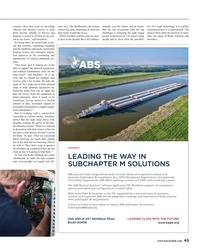 )
November 2017 - Maritime Reporter and Engineering News page: 43
)
November 2017 - Maritime Reporter and Engineering News page: 43owners) when they need us, providing cient way. The Dashboards can contain astically eyes the future, and he knows ties. It is high technology, it is satellite ef? cient and effective service to keep various key data, depending on what the that his top investment (and his top communications, it is
-
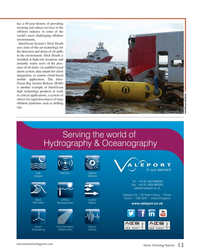 )
July 2017 - Marine Technology Reporter page: 13
)
July 2017 - Marine Technology Reporter page: 13for client integration, or remote cloud-based mobile application. The Inter- Ocean Rig Anchor Release (RAR) is another example of InterOcean high technology products at work in critical applications, a system of choice for rapid disconnect of large offshore platforms such as drilling rigs. InterOcean
-
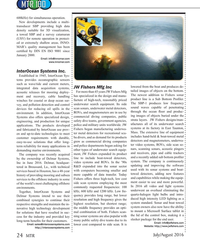 )
July 2016 - Marine Technology Reporter page: 24
)
July 2016 - Marine Technology Reporter page: 24shortest range; system standard. Sonar and boat towed respective strengths and maintain the in- system owners also now have the ability novative high technology development the middle frequency provides an opti- to mount a Microsoft Surface tablet in mal combination of both. Fishers scan- for solutions
-
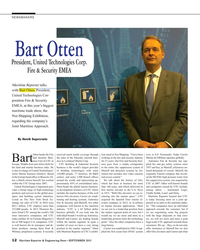 )
September 2015 - Maritime Reporter and Engineering News page: 12
)
September 2015 - Maritime Reporter and Engineering News page: 12Finnish company that invent- in the Europe head of? ce in Brussels, Ot- centers, and some 2,500 branch of? ces and access control.” ed the HI-FOG high pressure water mist ten, a Dutch citizen himself, has worked around the world, and representing ap- We talk about the history of Otis, ? re suppression
-
 )
August 2015 - Maritime Reporter and Engineering News page: 64
)
August 2015 - Maritime Reporter and Engineering News page: 64in ports and second, there is now Green Energy plus a ing emissions from busses and trucks in where the engine in the system only an incentive for high technology manu- Viable Business Case the world’s major cities has been a ma- powers a generator and is not mechani- facturers to invest in developing highly
-
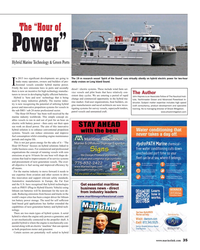 )
July 2015 - Maritime Reporter and Engineering News page: 35
)
July 2015 - Maritime Reporter and Engineering News page: 35power. Firstly the new emissions laws in ports and secondly diesel / electric systems. These include wind farm ser- there is now an incentive for high technology manufac- vice vessels and pilot boats that have relatively con- The Author turers to invest in developing highly ef? cient batteries. sistent
-
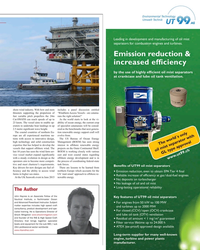 )
May 2015 - Maritime Reporter and Engineering News page: 41
)
May 2015 - Maritime Reporter and Engineering News page: 41energy support craft will rope are all experienced maritime na- evolve from. tions with access to innovative design, The US Bureau of Ocean Energy high technology and solid construction Management (BOEM) has seen strong expertise that has helped to develop the interest in offshore renewable energy vessels
-
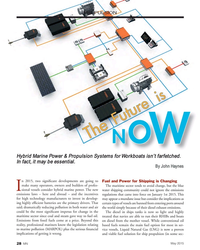 )
May 2015 - Marine News page: 28
)
May 2015 - Marine News page: 28not ignore the emissions I emissions laws – here and abroad – and the incentives regulations that came into force on January 1st 2015. This for high technology manufacturers to invest in develop- may appear a mundane issue but consider the implications as ing highly ef? cient batteries are the primary
-
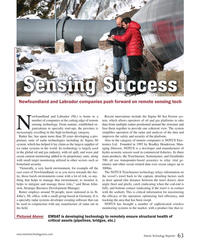 )
March 2015 - Marine Technology Reporter page: 63
)
March 2015 - Marine Technology Reporter page: 63and Nganizations to specialty start-ups, the province is fuse them together to provide one coherent view. The system increasingly excelling in this high technology category. simpl
-
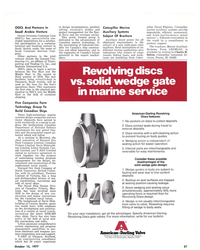 )
October 15, 1977 - Maritime Reporter and Engineering News page: 25
)
October 15, 1977 - Maritime Reporter and Engineering News page: 25by OOCL into the Middle East in the field of container shipping. Five Companies Form Technology Group To Build Canadian Ships Three high-technology marine systems design companies and two major shipyards have agreed to work exclusively as a group to ad- dress the forthcoming Canadian
-
 )
December 1977 - Maritime Reporter and Engineering News page: 28
)
December 1977 - Maritime Reporter and Engineering News page: 28Institute of Technology and is a registered professional engineer. CADCOM is a recognized leader in the practical applications of high technology, serving industry and government in automation, computer-aided design / manufac- turing, engineering analysis and design, environmental
-
 )
July 15, 1978 - Maritime Reporter and Engineering News page: 16
)
July 15, 1978 - Maritime Reporter and Engineering News page: 16, has received a new name—Bailey Controls Company. "Our new name more accurately reflects the true nature of our business today, which is high technology control and instrumenta- tion systems and products for the electric utility, industrial processes and marine in- dustries," said Bailey president
-
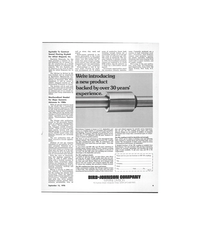 )
September 15, 1978 - Maritime Reporter and Engineering News page: 7
)
September 15, 1978 - Maritime Reporter and Engineering News page: 7has a $72-million annual payroll. Investment opportunities await the secondary industry manufac- turer. Currently produced are a number of high technology prod- ucts— footwear, food products, cement, steel products, contain- ers, paints, varnishes, wallboard, chemicals, and boats ranging from
